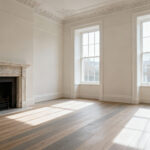I remember being a teenager and discovering my grandmother’s trunk of old silk saris. The scent of sandalwood, the flash of peacock blue and marigold yellow, the intricate zari thread work—it was like unlocking a secret world of color and story. That feeling, of seeing objects not just as things but as vibrant storytellers, is the universal spark that ignites a teen’s desire for a space that is truly their own. That moment of awakening is what separates a bedroom that is thoughtfully woven with personality from one that is simply an accidental collection of stuff.
As a designer who lives and breathes the dance between India’s rich artistic heritage and crisp contemporary lines, I believe a room should be a biography written in texture, color, and light. For a teen, this is more vital than ever. Their bedroom is their first studio, their sanctuary, their personal gallery. It’s a sacred space where their identity is blossoming, free from the world’s gaze. Our job is not just to decorate it, but to give them the tools to make it a resonant and authentic reflection of their spirit.
We’ll journey through this together, building from the ground up. We’ll begin with Teen Bedroom Fundamentals, establishing a strong foundation with evocative color and impactful art. From there, we’ll Elevate Your Teen Bedroom Design Approach, learning to layer textiles and balance palettes like a seasoned artist. For those ready to craft something truly unique, we’ll explore Advanced Teen Bedroom Design Strategies, mastering the artful chaos of pattern mixing and creating bespoke solutions for tricky spaces.
Finally, we’ll achieve Teen Bedroom Aesthetics: Expert Integration, weaving in elements like circadian lighting and the profound calm of nature-inspired design. This is about more than just trends; it’s about empowering a young person to create a space that nurtures, inspires, and tells their incredible, unfolding story. Let’s begin.
Getting Started with Teen Bedroom Fundamentals (Part 1)
This is where the magic starts—laying the foundational threads that will become a rich and personal tapestry. We’re not just picking things; we’re making intentional choices about color, light, and personality that will set the stage for a truly expressive sanctuary. This is the heart of creating brilliant bedroom ideas for teens.
1. Choosing a Dominant Hue for Personal Expression
The color of a room is its soul. It’s the first thing you feel when you walk in, setting the emotional tone before a single object is even noticed. For a teen, this choice is a powerful declaration of identity. Forget trends for a moment and listen to instinct. Are they drawn to the deep, meditative indigo of a desert night sky, the sun-baked terracotta of a Jaipur courtyard, or the lush, vital green of a Keralan jungle? This feeling is your North Star.
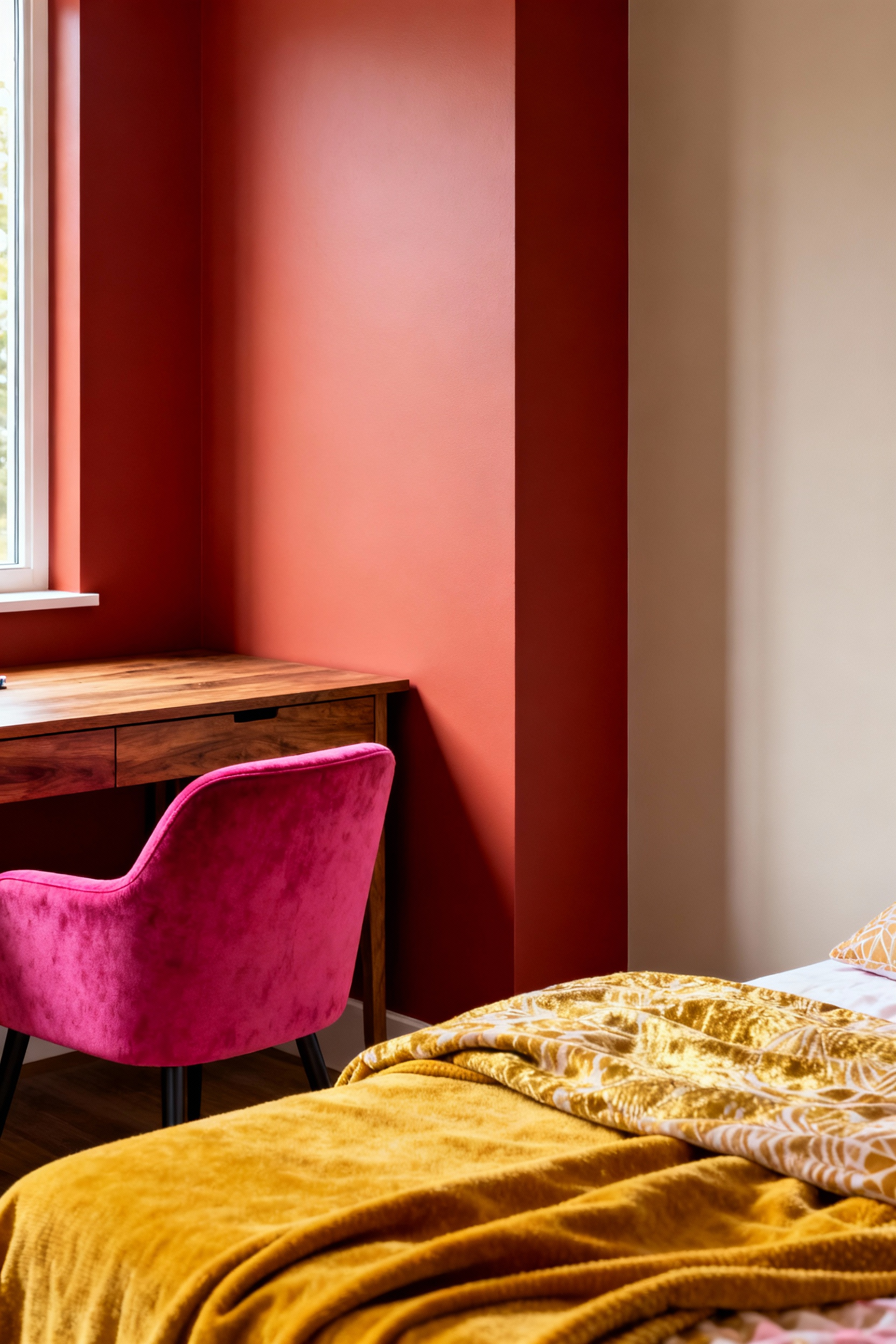
From here, we can bring in a bit of design wisdom. A dominant color doesn’t just express emotion; it manipulates light and space. In my Indo-Contemporary fusion practice, I always say that a color’s undertone is its secret language. A sapphire blue with a hint of violet feels royal and creative, while one with a touch of green feels more tranquil and earthy. This single decision will guide every other choice, from the wood of the furniture to the patterns in the textiles. Test swatches on different walls, and watch how the morning light makes them sing and the evening light makes them whisper. This elevates “picking a color” to an act of true intention.
2. Incorporating Thematic Wall Decals for Instant Impact
A blank wall is a beautiful invitation for personality. And while a hand-painted mural is a dream, wall decals offer that same stunning impact without the long-term commitment—perfect for the beautifully fluid world of a teenager. They are brilliant storytellers, instantly transforming a plain surface into a focal point. They offer an amazing way to bring art into the room with ease.

Think beyond simple quotes. A sprawling mandala decal behind the bed can create a gorgeous, meditative anchor for the room. A delicate pattern of golden paisley shapes tumbling down from the ceiling can add a touch of whimsical elegance. For a more graphic look, bold geometric patterns inspired by Art Deco architecture can define a study nook. Placement is everything. What I love about decals is that they aren’t just decoration; they can be integrated into the room’s narrative. Imagine a beautiful decal of a flowering tree, with tiny, floating shelves placed on its “branches” to hold treasured objects.
3. Optimizing Lighting Zones for Mood and Task Definition
Lighting is the unsung hero of design. It’s the invisible element that sculpts mood, directs focus, and can make a space feel either expansive or intimate. Most rooms start with a single overhead light, but that’s like trying to paint a masterpiece with only one color. A teen’s room is a multi-verse of activity—it needs lighting that can keep up.
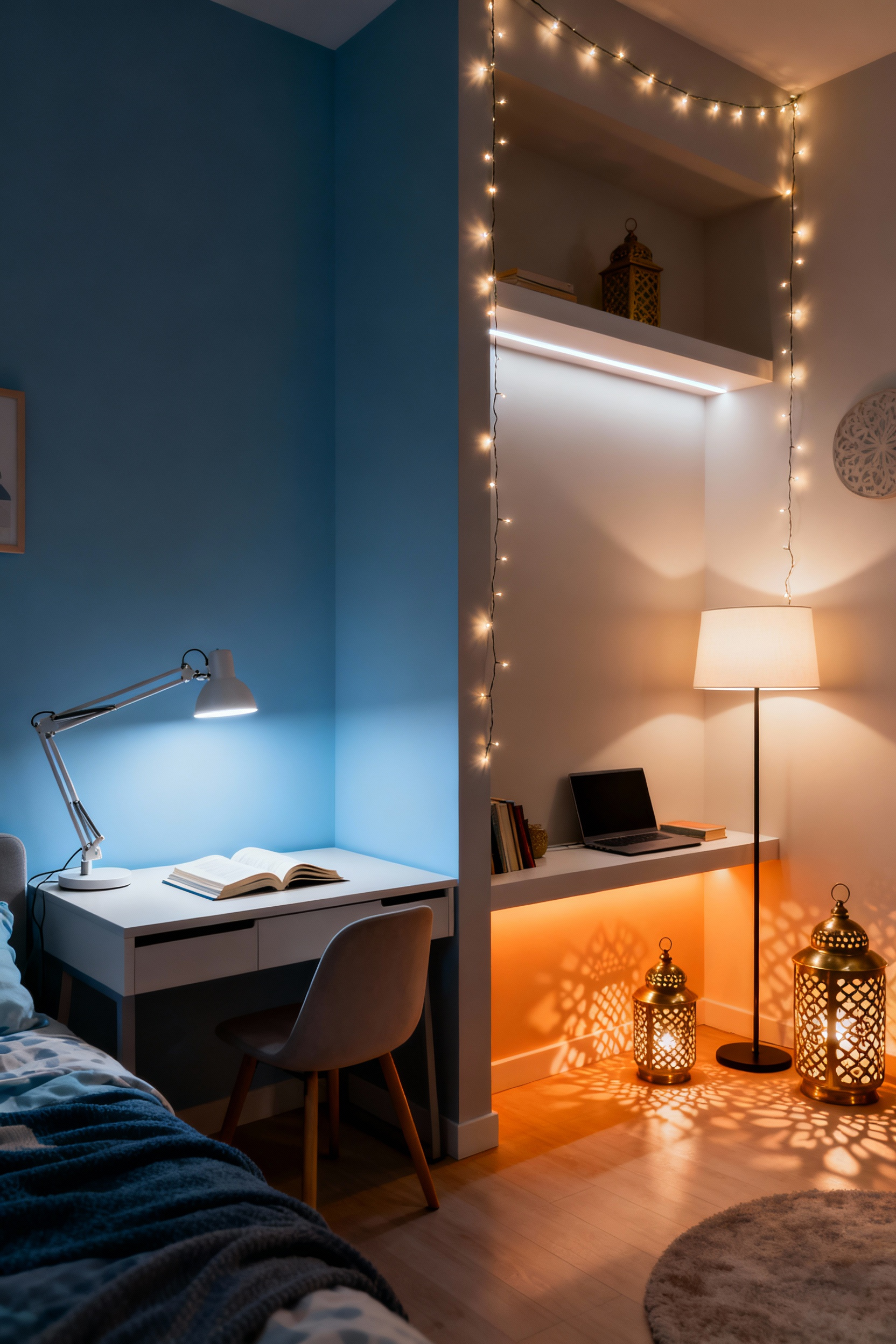
We create this versatility by layering three types of light: ambient (overall illumination), task (for focused work like studying or art), and accent (for pure drama and personality). What I’ve seen in my professional experience is that warmth is key to creating a sanctuary. Use warmer bulbs (around 2700K) for ambient and accent lighting to create a cozy, inviting glow, reminiscent of candlelight or a fireplace. Keep the cooler, brighter light contained to a dedicated desk lamp for focus. Think of fairy lights as sparkling jewelry for the room, or a sculptural floor lamp in a corner as a piece of glowing art. Dimmers are non-negotiable—they give ultimate control, allowing the room to transition from a bright, energetic hub to a serene, restful haven at the flick of a switch.
4. Curating a Collection of Personalized Soft Furnishings
If color is the room’s soul, textiles are its heart. They bring in softness, warmth, and the human touch of artistry. Soft furnishings are the easiest, most joyful way to inject personality and update a space as a teen’s style evolves. Start with the bed—it’s the largest textile landscape in the room. A beautiful duvet cover, perhaps a soft, hand-blocked printed cotton from Sanganer, is a perfect starting point.
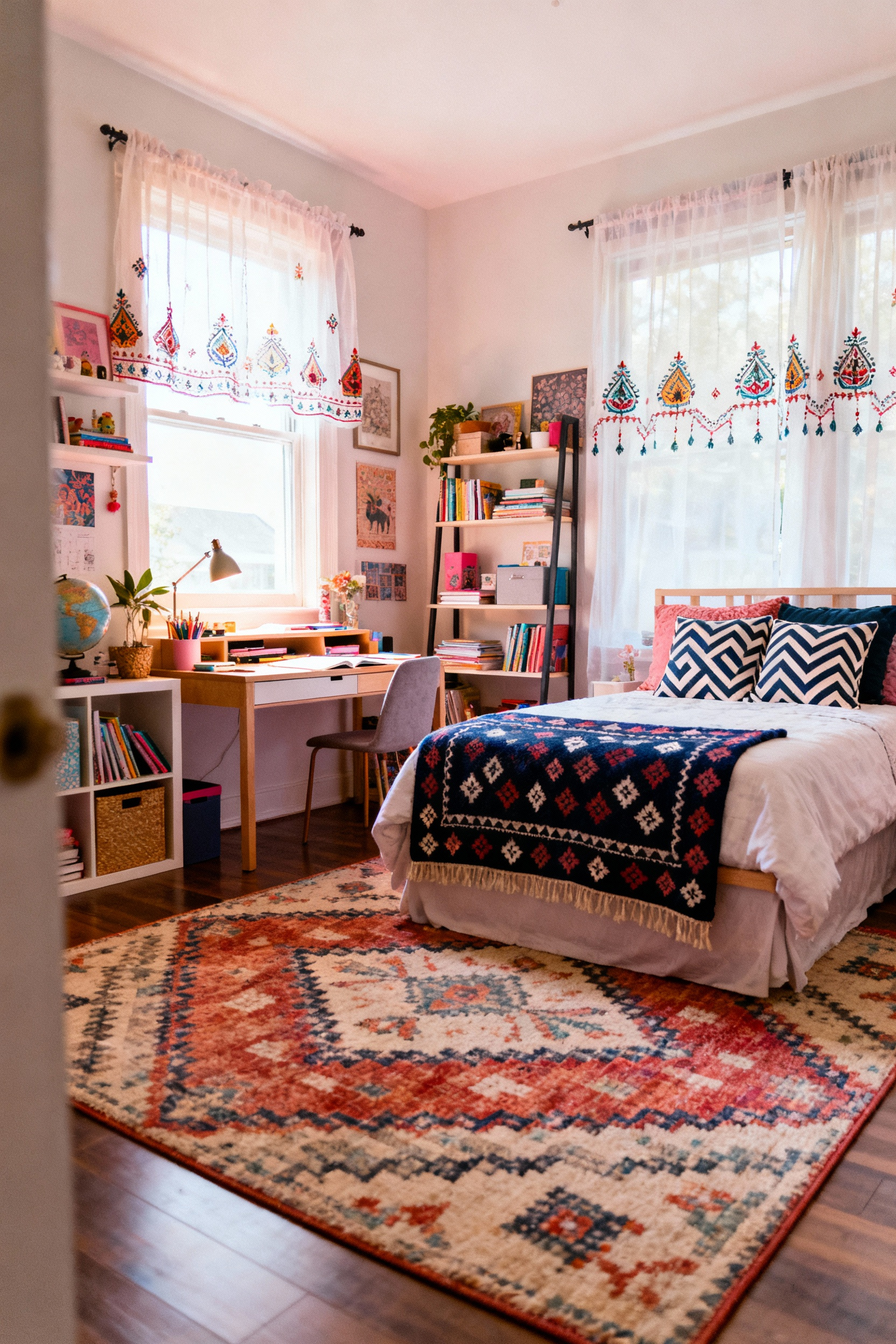
Now, let’s layer. This is where the magic happens. Imagine piling on cushions in contrasting textures—plush velvet, rustic slub silk, embroidered cotton. Add a chunky hand-knit throw or a lightweight kantha stitched quilt at the foot of the bed. Don’t be shy! A gorgeous rug under the bed not only feels wonderful underfoot but also anchors the entire space. What I tell my clients is to think of textiles as wearable art for your room. They are an incredible vehicle for introducing pattern and telling a story—of places you love, crafts you admire, and colors that make your spirit soar.
Getting Started with Teen Bedroom Fundamentals (Part 2)
Here we go deeper, transforming everyday elements into powerful statements of style and ingenuity. These bedroom ideas for teens are about looking at the familiar with fresh eyes and seeing the potential for beauty and personal expression in unexpected places.
5. Crafting a Statement Headboard with Found Materials
The space behind the bed is prime real estate for a dramatic statement, and you don’t need a huge budget to make a huge impact. Crafting a headboard from found or reclaimed materials is one of my favorite ways to infuse a room with soul and story. Think outside the box! An old carved wooden door, found at a salvage yard, can be mounted to the wall for a stunning, architectural piece with a history.
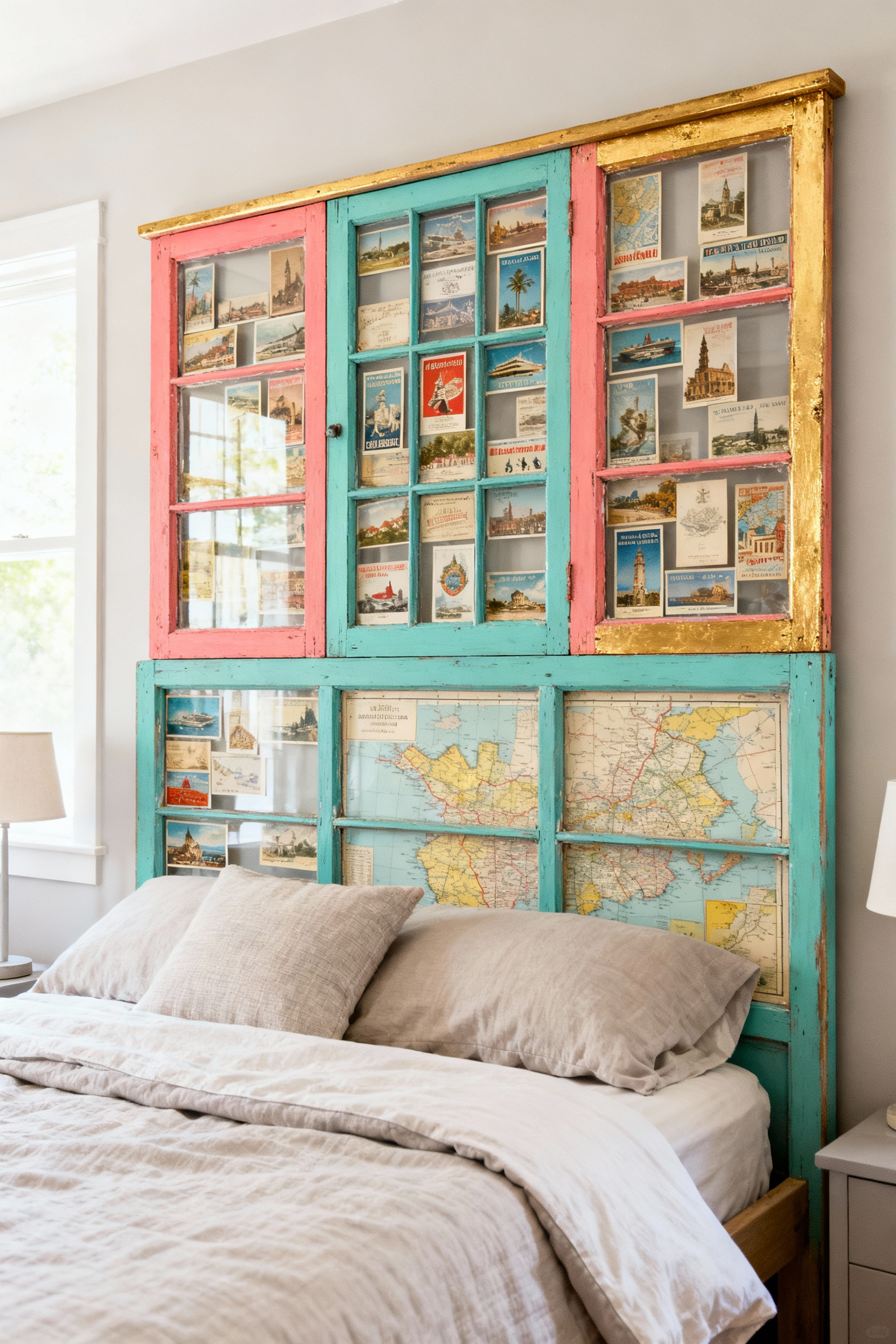
This is where true creativity comes into play. A series of woven jute placemats arranged in a grid can create a wonderfully textural, bohemian headboard. For a softer touch, find a beautiful piece of fabric—maybe a vintage suzani tapestry or a bold piece of printed velvet—and wrap it around a simple piece of plywood. I once helped a client create a headboard from the borders of her mother’s old silk saris, weaving them together to create a priceless and deeply personal piece of art. This approach transforms a functional item into a conversation-starting masterpiece that is one hundred percent unique.
Elevating Your Teen Bedroom Design Approach (Part 1)
Now that our foundation is set, it’s time to refine our approach, layering in more sophisticated design principles. This section is all about transforming a “decorated” room into a “designed” one, where every choice is intentional and contributes to a harmonious, inspiring whole. These bedroom ideas for teens focus on creating balance and flow.
6. Strategically Layering Textiles for Tactile Depth and Comfort
Layering textiles is an art form that transforms a room from flat and functional to rich, deep, and incredibly inviting. We started with the basics, but now we think about the entire sensory experience. The goal is to create a delightful interplay of textures that begs to be touched. Imagine the smoothness of a silk pillow against the nubbly texture of a linen duvet, with the plush softness of a faux fur rug underfoot.
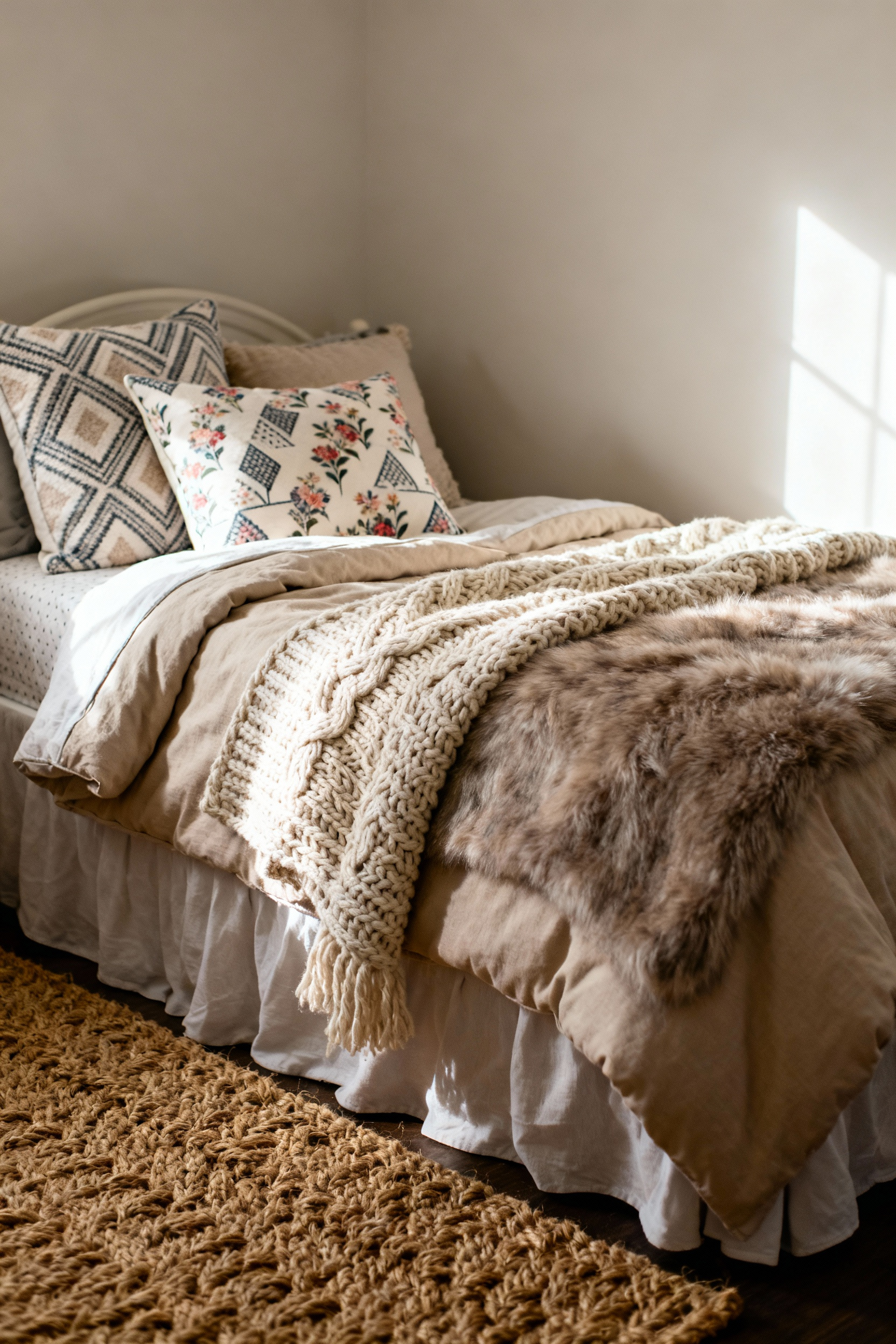
This is also where we can play with visual weight. A delicate, sheer curtain filters light beautifully and adds an ethereal quality, while a heavy velvet drape adds drama, absorbs sound, and creates a cozy, cocoon-like feeling. In my Indo-Contemporary fusion specialist practice, I always tell clients that layering patterns is like blending spices—you need a dominant flavor, a complementary note, and a surprising accent to create something truly magical. So, don’t be afraid to mix a large-scale floral with a small geometric print, as long as they share a common color thread to tie them together. This creates a room that feels collected and curated over time.
7. Employing a Balanced Color Palette for Harmony and Energy
We’ve chosen a dominant color, but a truly sophisticated space is a symphony of hues, not a single note. A balanced palette brings a room to life, creating both harmony and energetic tension. The 60-30-10 rule is a wonderful, simple guide for this. Your dominant color (the soul of the room) should cover about 60% of the space—think walls, maybe a large rug. A secondary color takes up 30%—this could be your curtains, bedding, or an accent chair.
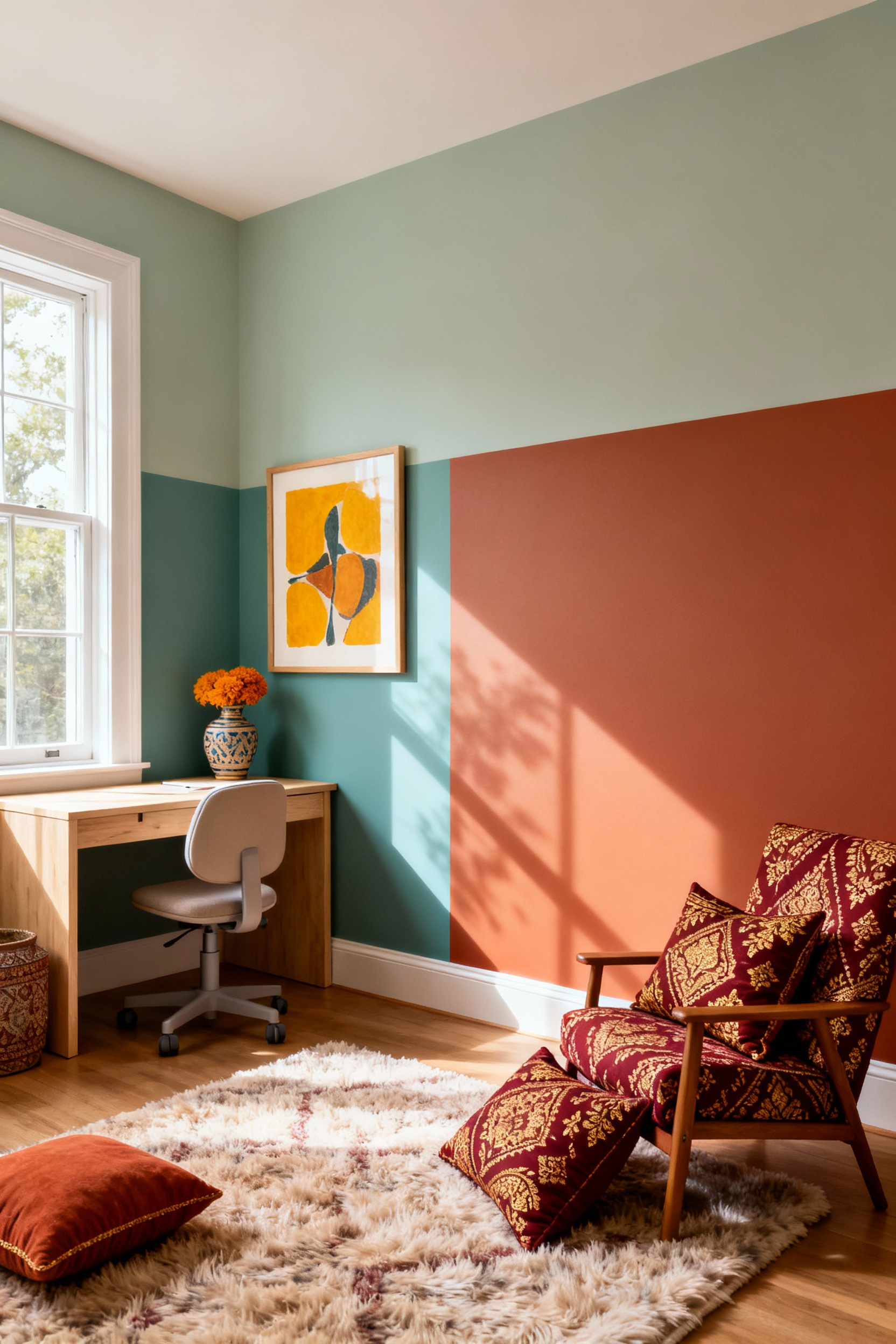
The final 10% is where the fireworks happen. This is your accent color—a vibrant pop that adds excitement and personality. It’s the unexpected turquoise cushion on a navy sofa, the flash of fuchsia in a piece of art. This is also where you can introduce metallics—a touch of brass, copper, or polished nickel adds a layer of glamour and reflects light beautifully. I learned this when studying Indian miniatures: even the most serene paintings often have a tiny, brilliant slash of color that brings the whole scene to life. That’s what your 10% accent does for your room.
8. Designing Multifunctional Furniture Arrangements for Evolving Needs
A teenager’s room is the ultimate multi-purpose space—it has to be a classroom, a lounge, a dressing room, and a peaceful retreat all at once. The key to making this work without feeling cluttered is clever, multifunctional furniture. This is design that works as hard as you do. A beautiful daybed or a chic futon is perfect for this, serving as a stylish sofa for hangouts and transforming into a cozy bed at night.

Loft beds are a brilliant solution for smaller spaces, freeing up precious floor area for a desk, a reading nook with a comfy beanbag, or even a mini walk-in closet. Look for pieces that do double duty: an ottoman with hidden storage for blankets, a mirror that opens to reveal jewelry organization, or a headboard with built-in shelving. In my professional experience, the most successful teen rooms feel spacious not because they are big, but because every piece of furniture is working smart. This approach ensures the room can adapt and evolve as needs change, from high school study sessions to college prep.
9. Integrating Smart Storage Solutions to Maximize Spatial Efficiency
An orderly room creates a calm mind. Smart storage isn’t about hiding things away; it’s about creating an intuitive, efficient system that makes it easy to keep the space serene and beautiful. We need to look beyond the basic closet and dresser and tap into every underutilized inch of the room. Vertical space is your best friend—think shelves that go all the way up to the ceiling for books and collections.
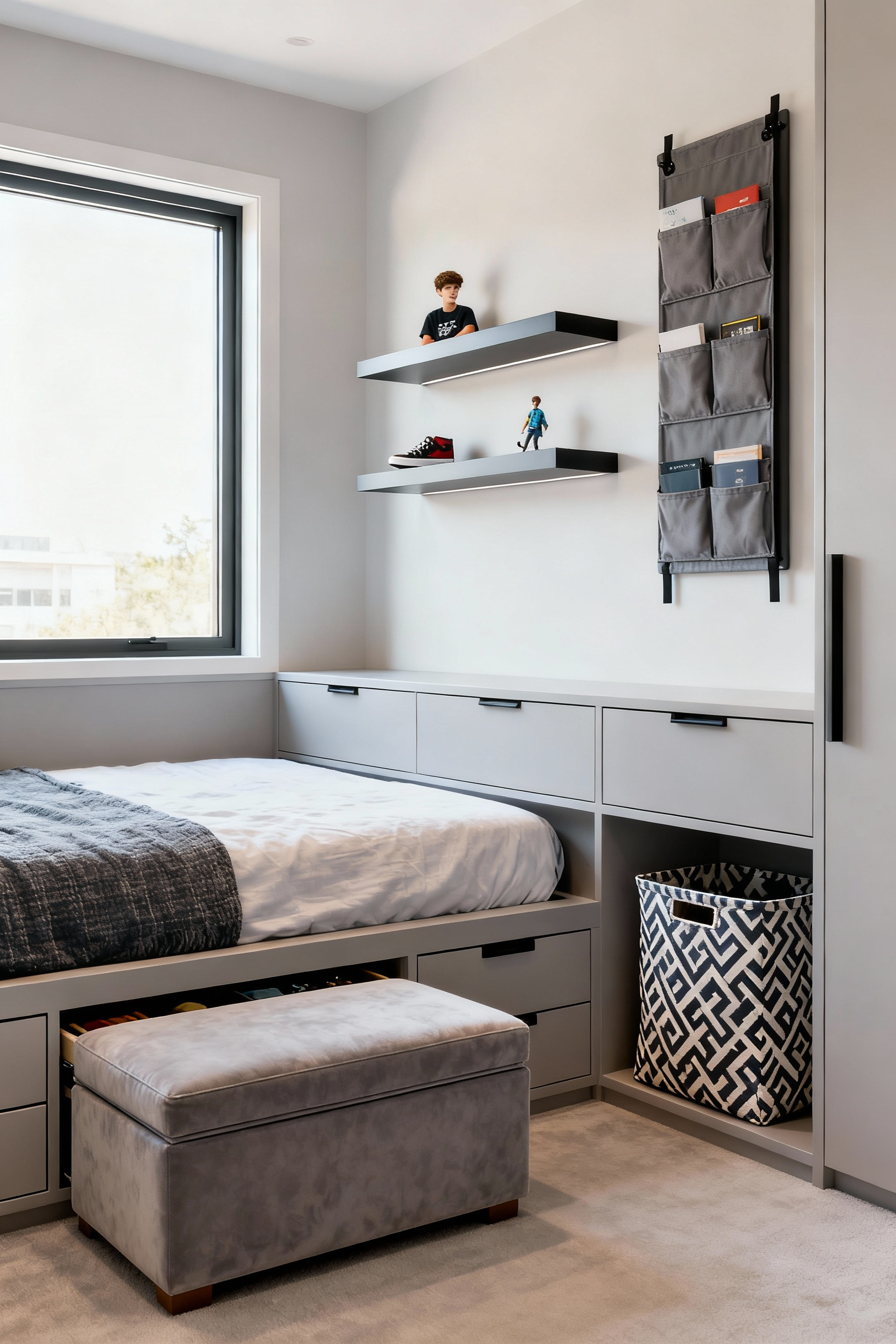
Under-the-bed storage is non-negotiable for stowing away seasonal items or extra bedding. But let’s elevate it. Instead of plastic bins, consider beautiful woven baskets or custom drawers that feel like a seamless part of the bed frame. What really gets me excited is storage that doubles as display. A stylish pegboard can be an ever-changing gallery for art, accessories, and tools. Floating shelves arranged artfully on a wall turn a collection of treasured objects into a design feature. It’s about creating a home for everything, so the personality of the teen and the design of the room can shine through, uncluttered and calm.
Elevating Your Teen Bedroom Design Approach (Part 2)
Here, we transition from individual design elements to a more holistic vision. It’s about seeing the room as a dynamic ecosystem where different activities can coexist harmoniously. These advanced bedroom ideas for teens are rooted in intelligent spatial planning to create a space that truly supports every facet of their life.
10. Defining Distinct Zones for Relaxation, Study, and Hobbies
A teen’s room isn’t just one room; it’s three or four rooms in one. By consciously creating distinct “zones” for different activities, you bring a sense of order and purpose to the space, which can profoundly impact focus and well-being. This doesn’t require walls—it’s all about clever visual cues. You can define a study zone with a desk, good task lighting, and a pinboard for inspiration, creating a clear “work mode” area.
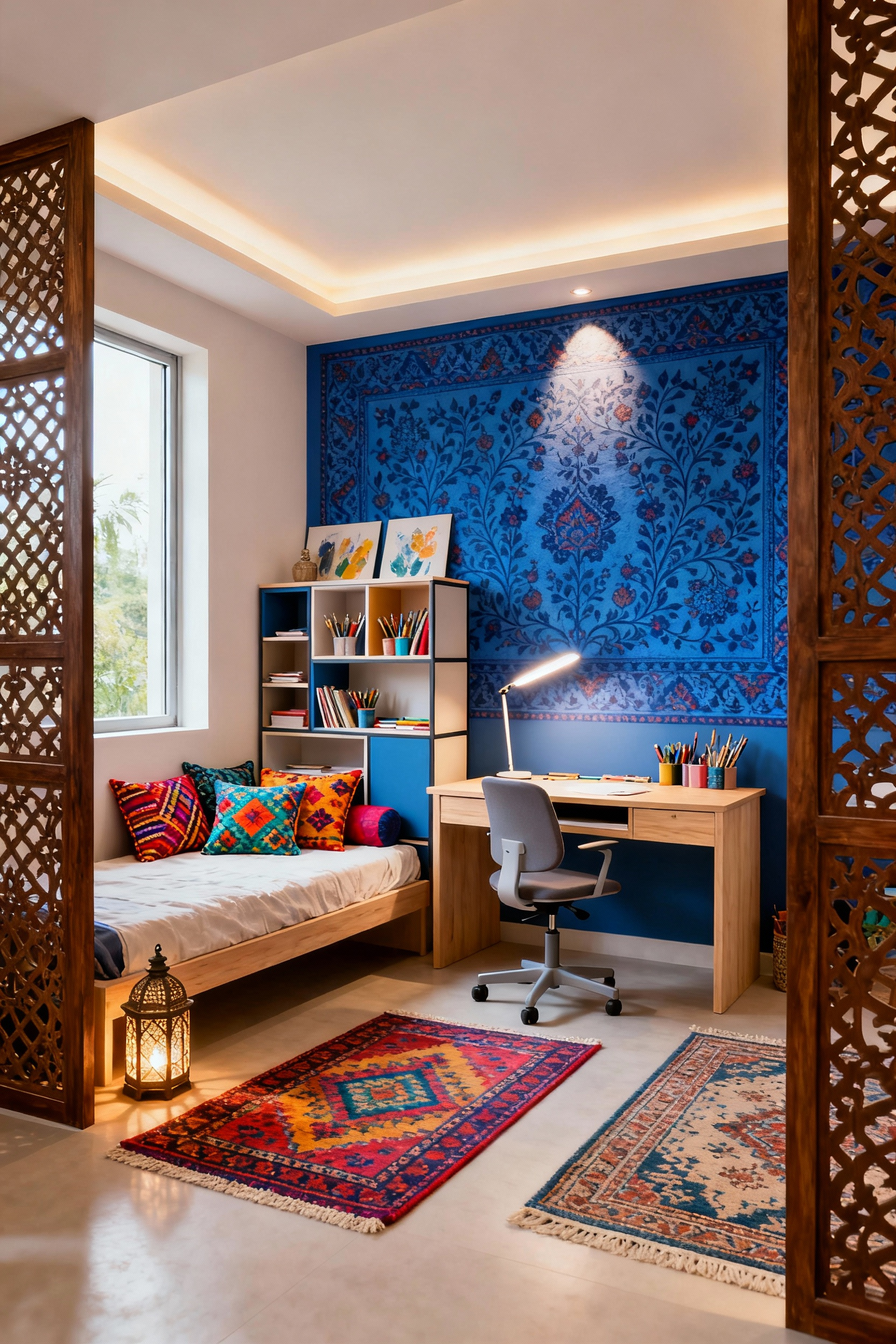
A relaxation zone can be as simple as a comfy armchair or a pile of floor cushions in a corner, paired with a soft rug and a small side table. The hobby zone—be it for music, art, or gaming—gets its own dedicated spot with tailored storage for all the necessary gear. What I’ve noticed is that these zones create mental boundaries as well as physical ones. It’s easier to unwind in your relaxation corner when it’s visually separate from your desk. This thoughtful division allows each part of their life to have its own stage, creating a harmonious environment where they can seamlessly shift from productive to playful to peaceful.
Advanced Teen Bedroom Design Strategies (Part 1)
Now we’re ready to embrace the role of artist and curator. This is where we play with the more complex, expressive elements of design. These bedroom ideas for teens are for those who are ready to move beyond the rules and craft a space that is a bold, sophisticated statement of their unique point of view.
11. Mastering Pattern Mixing for a Cohesive Yet Dynamic Aesthetic
Ah, the glorious, joyful art of mixing patterns! So many people are afraid of it, but it’s the secret to a room that feels soulful, collected, and full of life. The key isn’t chaos; it’s curation. Start by choosing a “hero” pattern—a large-scale, dramatic print that you absolutely love. This could be a stunning floral for a duvet cover or a bold geometric for a rug. This is your anchor.
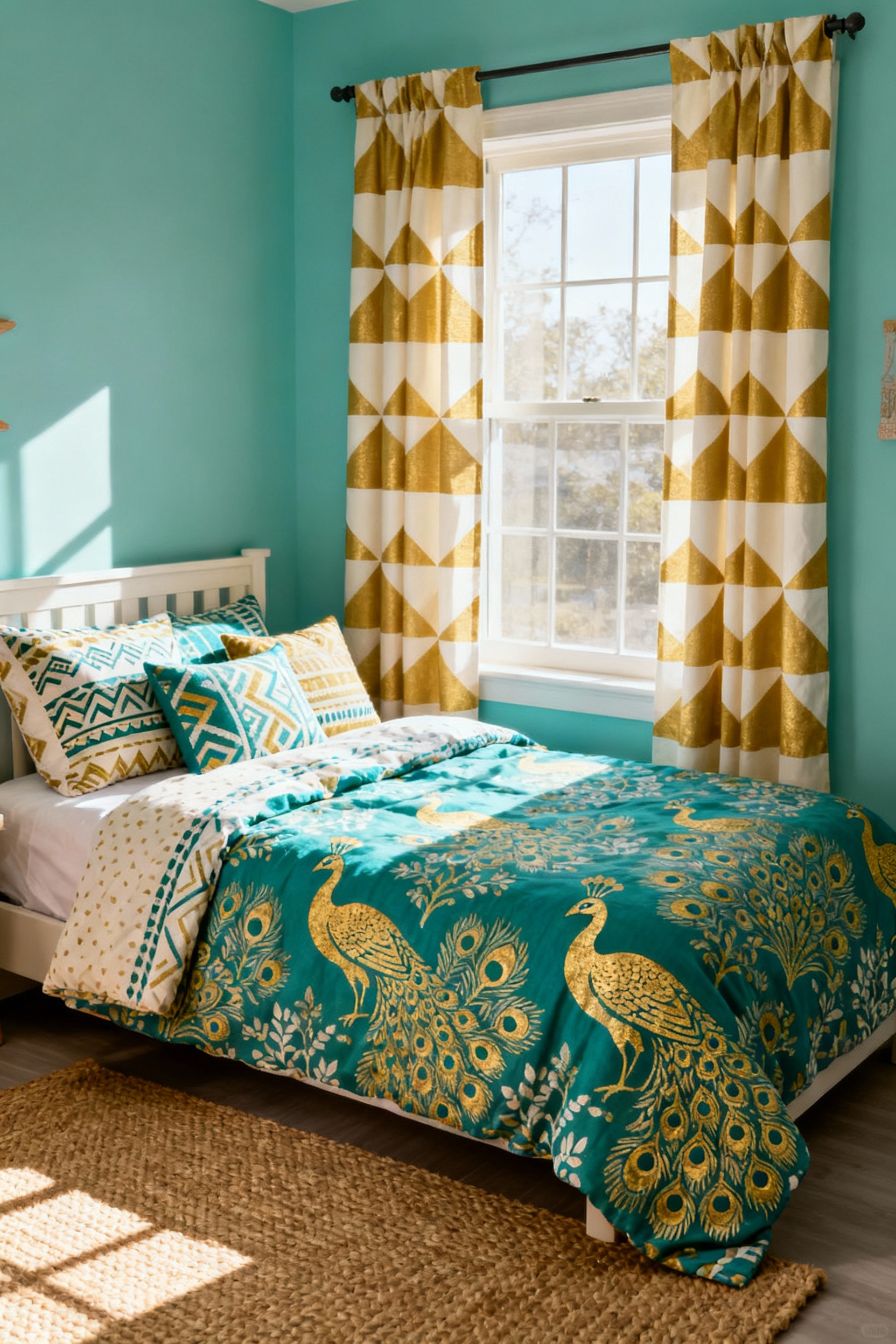
Now, build around it with smaller-scale patterns that live in the same color family. A medium-scale stripe or a simple polka dot can complement a bold floral beautifully. Then, add in a small, detailed print—like a tiny paisley or a delicate buti motif—for an accent cushion. My years of working with Indian textiles taught me this: when patterns share a color story, they can dance together beautifully without clashing. You can also mix in texture as a “solid” pattern—a chunky knit or a raw silk adds another layer of interest. The result is a dynamic, visually rich space that feels deeply personal and alive.
12. Utilizing Bespoke Joinery to Address Unique Spatial Challenges
Sometimes, off-the-shelf furniture just won’t cut it. Awkward corners, sloped ceilings, or specific storage needs are the perfect opportunity for bespoke joinery—custom built-in furniture that turns a room’s challenges into its greatest assets. This is the ultimate in smart, seamless design. Imagine a window seat with deep drawers for storage, creating a cozy reading nook out of an empty wall.
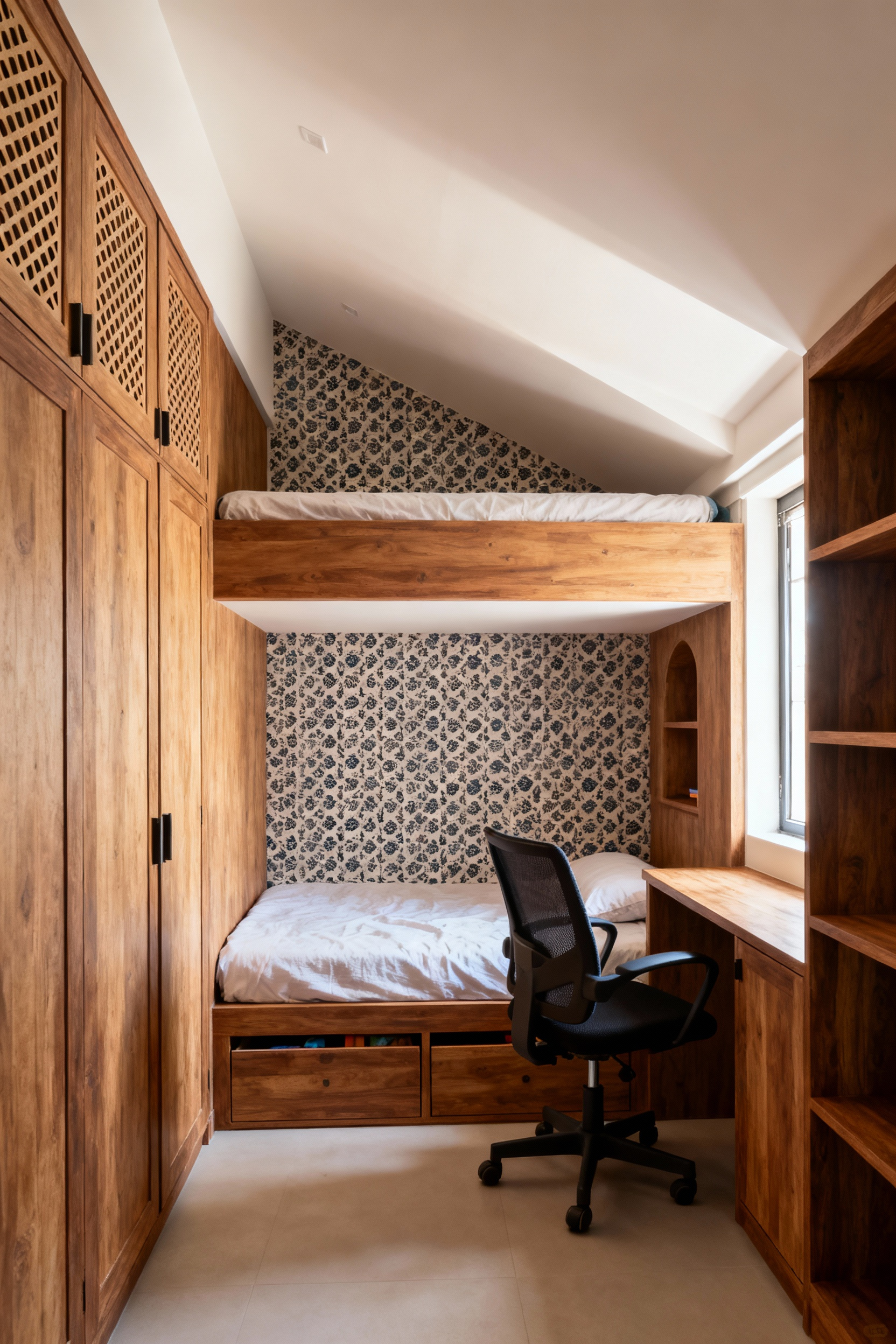
For a more sophisticated application, think about a floor-to-ceiling unit that combines a desk, bookshelves, and wardrobe into one streamlined, architectural piece. It maximizes every inch of space while creating a stunning, cohesive look. A platform bed with integrated drawers and side tables can eliminate the need for bulky extra furniture, making a room feel larger and more serene. Here’s what’s interesting: bespoke joinery isn’t just a practical solution; it elevates the entire feel of the room, making it feel custom-tailored and permanent, a truly solid foundation for any style.
13. Implementing Acoustic Paneling for Enhanced Sensory Comfort
In our wonderfully loud and connected world, a bedroom needs to be a true sanctuary—a place where you can shut out the noise and find peace. Acoustic comfort is a design layer that’s often overlooked but has a huge impact on well-being. This is especially true if the room is a hub for gaming, music practice, or just online hangouts with friends. Forget ugly industrial foam. Today’s acoustic panels are works of art in their own right.
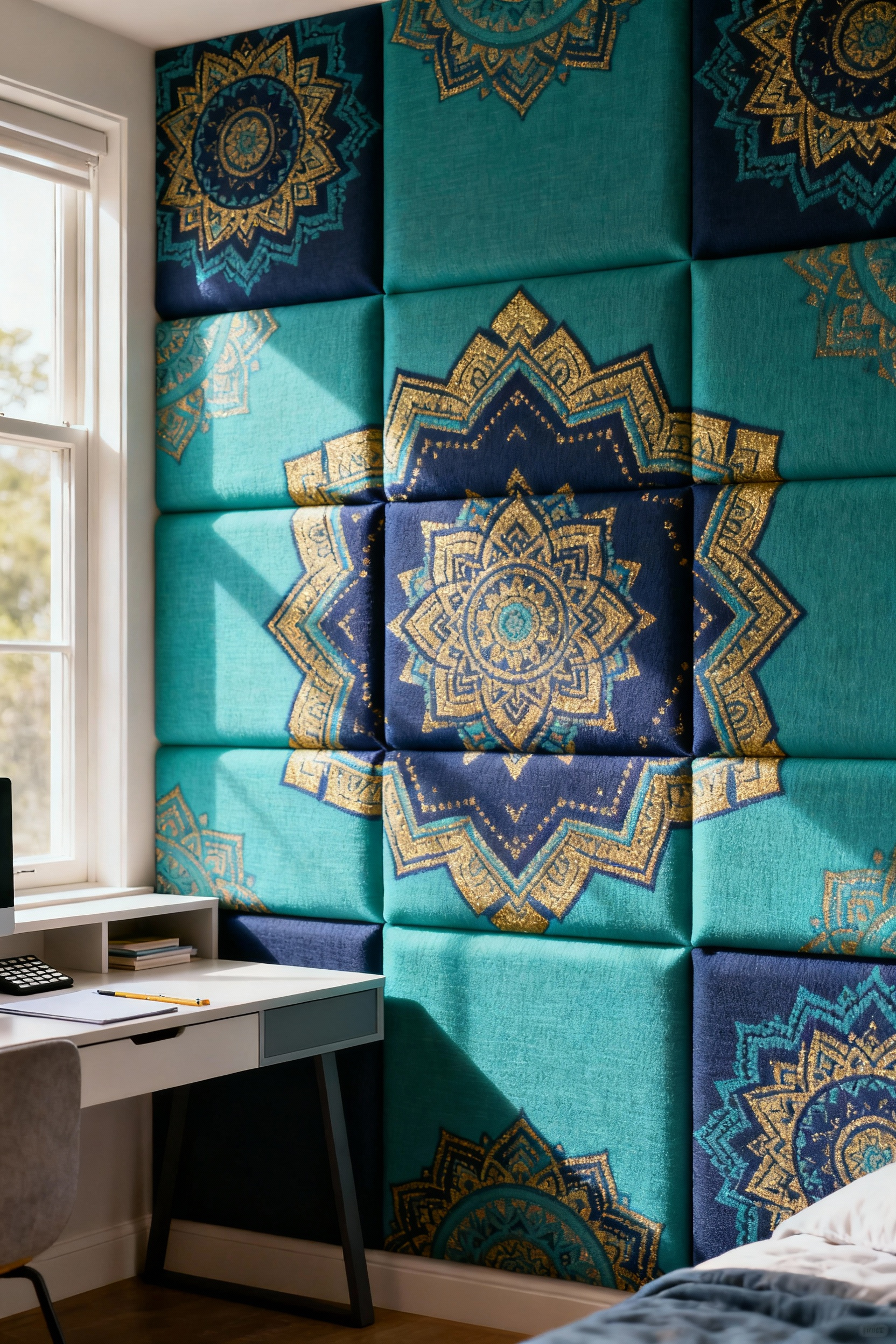
You can get beautiful felt panels in geometric shapes and rich colors that can be arranged on a wall to create a stunning, sound-absorbing feature. Slatted wood panels add warmth and texture while subtly managing echoes. Even a large, plush fabric-wrapped panel behind the bed can act as a soft headboard while making the room feel quieter and more cocoon-like. Good design appeals to all the senses, and creating a space that sounds as good as it looks is one of the most thoughtful bedroom ideas for teens. It’s about cultivating an environment of serene focus and sensory calm.
14. Crafting a Gallery Wall with Purposeful Narrative Flow
A gallery wall is so much more than a collection of pictures; it’s a visual diary, a storyboard of a teen’s life, passions, and dreams. An accessible start is to gather pieces you love and unify them with matching frames. But to elevate it, we need to think like a curator. Let’s create a narrative. Mix media: frame a cherished photo next to a concert ticket, a small mirror, a postcard, and a piece of embroidered fabric.

For a truly sophisticated gallery wall, play with unconventional layouts. Let it flow around a corner, climb up to the ceiling, or be anchored by a single, large “hero” piece. What really elevates a gallery wall is layering and depth. Incorporate a couple of small, shallow shelves into the arrangement to hold a tiny sculpture or a treasured object. This adds a three-dimensional quality that makes the entire wall feel more dynamic and alive. It transforms from a simple display into a deeply personal, ever-evolving installation that tells their unique story.
Advanced Teen Bedroom Design Strategies (Part 2)
We continue our dive into high-level design concepts, moving from curated collections to creating immersive micro-worlds within a single room. These bedroom ideas for teens are about using design to tell powerful, multi-layered stories and amplify personal passions.
15. Employing Themed Vignettes to Amplify Personality and Story
A vignette is a small, curated moment in a room—a tiny story told on a tabletop, a shelf, or in a corner. It’s a design strategy that allows you to express different facets of your personality without committing the entire room to a single theme. This is where you can let your passions shine. An aspiring astronomer could create a vignette on their bedside table with a constellation lamp, books about the cosmos, and a beautiful piece of raw amethyst.
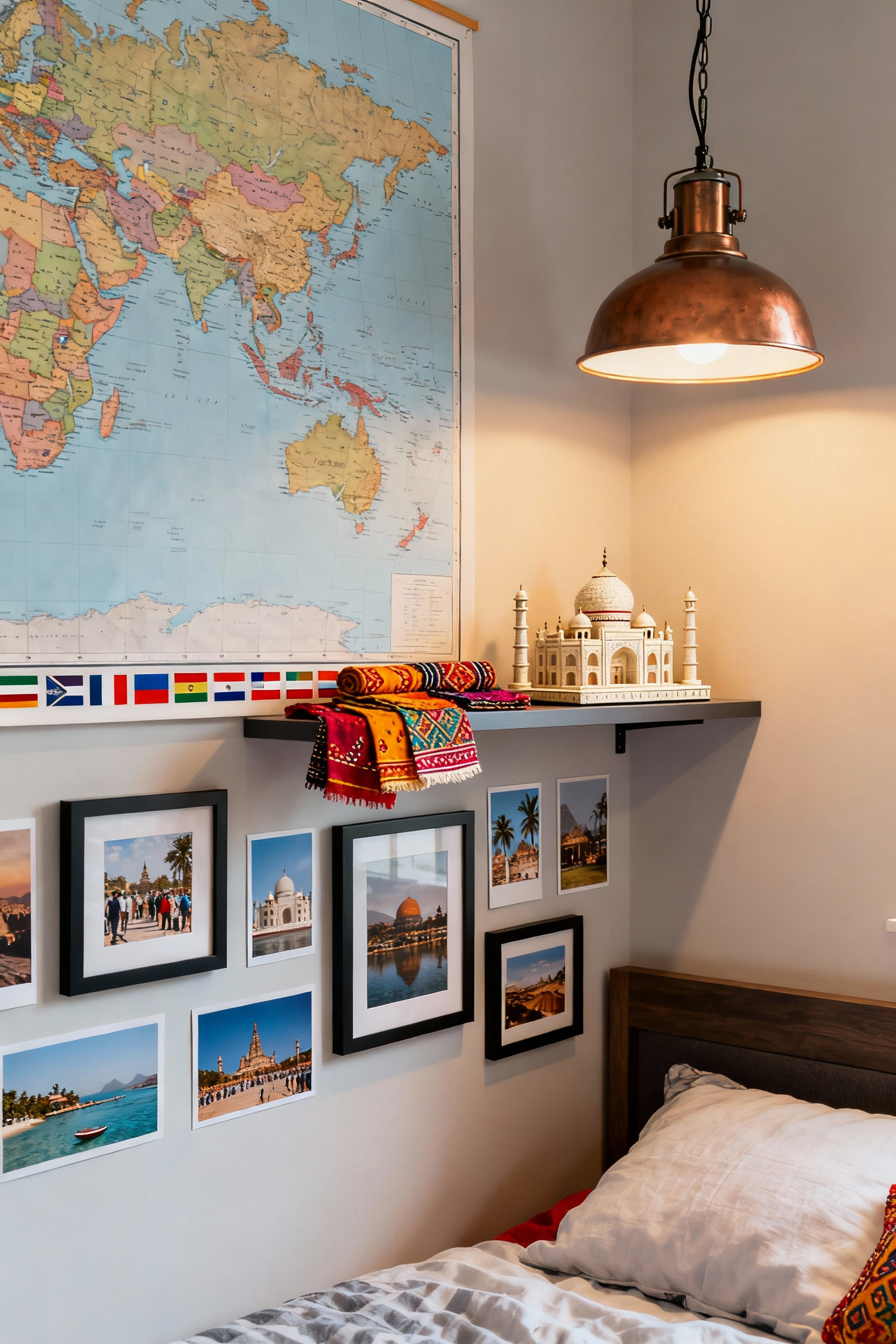
To create a sophisticated vignette, think in layers. Start with a foundation—a tray, a stack of books, or a beautiful piece of fabric. Add height with a vase or a small sculpture. Then bring in personal, meaningful objects and a touch of something living, like a small succulent. Lighting is crucial; a small, focused lamp can turn a simple arrangement into a dramatic focal point. In my professional experience, a few well-composed vignettes can make a room feel more personal and interesting than one overarching theme. They are dynamic and easy to change, allowing the room’s story to evolve as the teen’s passions do.
Mastering Teen Bedroom Aesthetics: Expert Integration (Part 1)
Here, we weave all our design threads together, integrating sophisticated concepts like lighting science and biophilia to create a space that doesn’t just look good but actively enhances well-being. These bedroom ideas for teens are about designing a truly holistic, nurturing environment.
16. Devising a Circadian Lighting Scheme for Optimized Well-being
This is where lighting design gets truly brilliant. Our bodies are naturally attuned to the sun’s rhythm, and circadian lighting brings that intelligence indoors to support our natural sleep-wake cycle. It’s about more than just on/off; it’s about the color and intensity of light throughout the day. The easiest way to do this is with smart bulbs, which allow you to change the light from cool to warm.

Imagine a lighting scheme programmed to mimic the sun: a cool, bright, energizing blue-toned light in the morning to help you wake up and focus on schoolwork. As the afternoon wears on, it can slowly transition to a warmer, softer, amber-toned light in the evening. I’ve seen this play out in so many homes; this simple shift signals to the brain that it’s time to wind down, promoting better, more restful sleep. This is one of the most profound bedroom ideas for teens because it’s a design choice that actively supports their physical and mental health, reducing eye strain and creating a naturally calming rhythm for their day.
17. Applying Biophilic Design Principles for Natural Serenity
Biophilia is the simple truth that we, as humans, have an innate need to connect with nature. Bringing natural elements into a bedroom is one of the most powerful ways to create a serene, grounding sanctuary. This goes way beyond just putting a plant in the corner—although that’s a beautiful start! It’s about weaving the patterns, textures, and materials of the natural world into the fabric of the room.

Use natural materials like wood, jute, linen, and wool. Choose bedding with a botanical print or wallpaper with a subtle leaf motif. Position the desk to have a view of the sky or a tree outside. I believe that even in the most urban environments, we can create this connection. Think about forms: furniture with soft, organic curves rather than hard angles. The goal is to create a space that feels calming, restorative, and alive—a gentle reminder of the peaceful, ordered beauty of the natural world.
18. Engineering Custom Digital Integration for Immersive Environments
For a modern teen, technology is an integral part of life. Instead of fighting it with a tangle of cords, we can design for it, integrating it seamlessly and beautifully into the room. This starts with practicalities: create a dedicated, stylish charging station, and use smart cable management to keep everything tidy. But the real fun is in creating immersive, custom experiences.
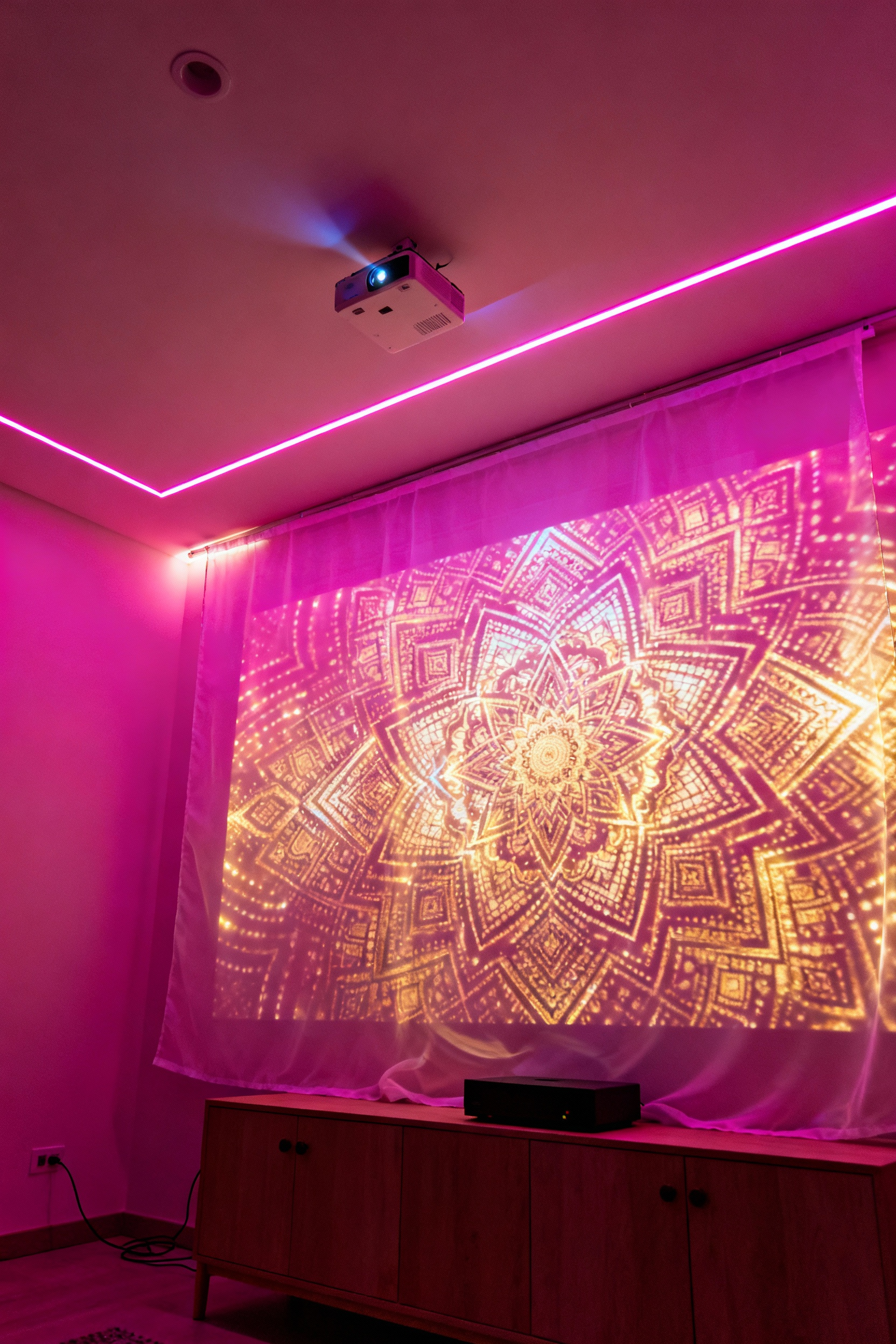
Think about a smart hub that can orchestrate “scenes.” A “Study Mode” could trigger cool, bright overhead light, turn off the TV, and play a focus-enhancing playlist. A “Movie Mode” could dim the lights, turn on accent lighting, and power up the sound system. An ultra-short-throw projector can turn a blank wall into a dynamic backdrop—displaying a calming forest scene for relaxation or a vibrant cityscape for energy. What I tell my clients is to think of technology as another design material, like wood or fabric, that can be used to shape the atmosphere and function of the room.
19. Forging a Signature Aesthetic Through Materiality and Form
This is the ultimate expression of personal style—moving beyond colors and objects to think about the fundamental language of design: materiality and form. It’s about understanding how different materials feel. The cool, smooth surface of marble; the warm, rugged grain of reclaimed wood; the industrial edge of raw steel; the soft, inviting plushness of velvet. Combining these textures thoughtfully is what gives a room depth and character.
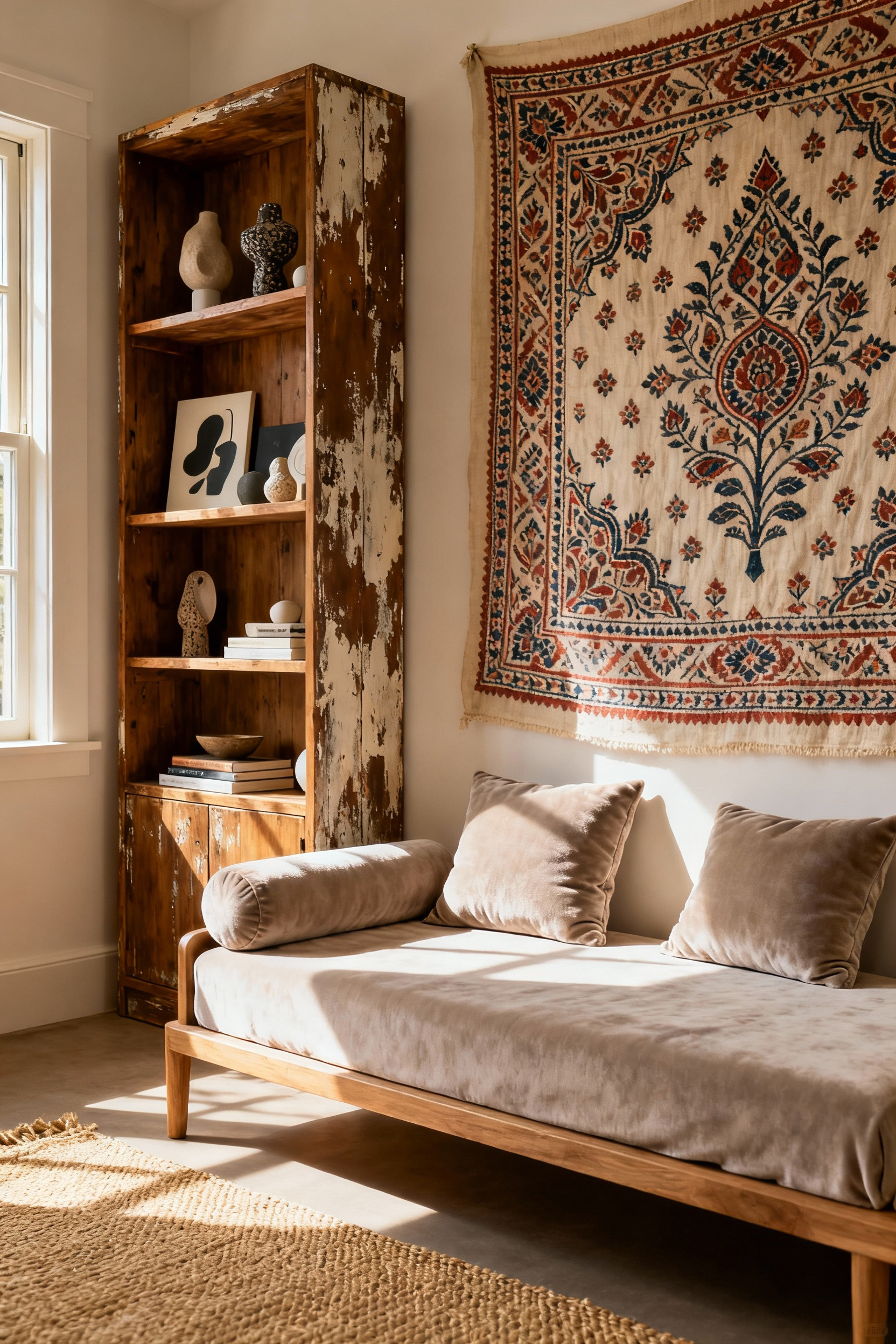
Form is the shape of things—the clean, straight lines of minimalist furniture versus the gentle, organic curves of a sculptural chair. This is where a teen can truly define their signature look. Do they love the drama of high-contrast materials, like black metal and light wood? Or the soft, tonal harmony of natural linens and ceramics? Years of Indian art integration have taught me that a limited palette of materials, used thoughtfully and repeatedly, can create a more powerful and cohesive statement than a room full of disparate things. This is how a space develops a true, unique soul.
Mastering Teen Bedroom Aesthetics: Expert Integration (Part 2)
We conclude with the most forward-thinking concept: creating a design system that isn’t static but is built for growth and change. This is the key to a space that remains a true reflection of self, year after year, embodying the most adaptable and personal bedroom ideas for teens.
20. Developing a Flexible Design System for Future Adaptability
A teenager’s world is one of constant, beautiful evolution. Their passions, tastes, and styles can shift and grow with incredible speed. The most intelligently designed room isn’t one that’s finished, but one that’s designed to change. This is about creating a flexible system—a strong, neutral foundation that can support countless style updates without a complete overhaul. Think of it as a beautiful, timeless canvas.
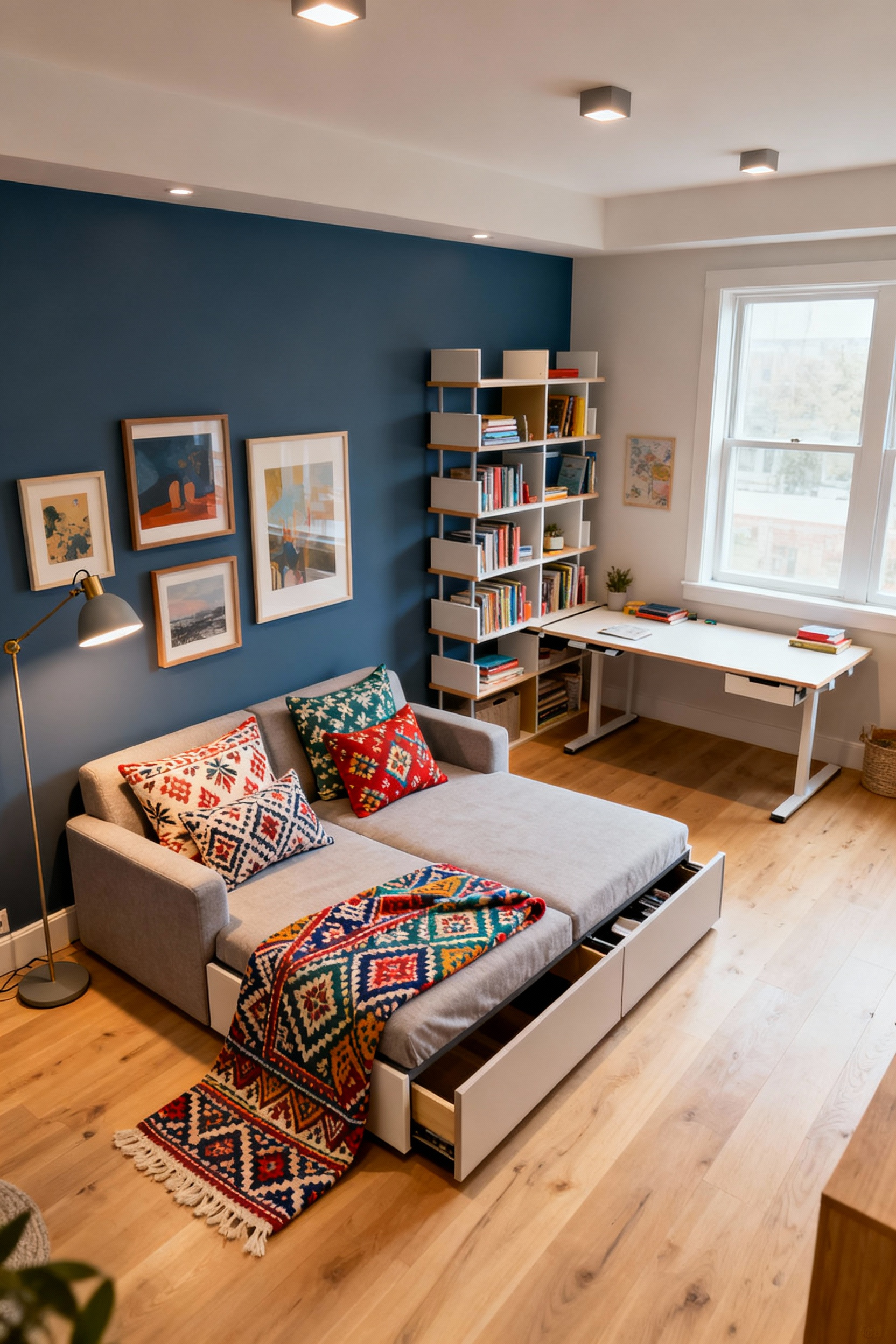
The “bones” of the room—the bed, the dresser, a good quality desk—should be classic and built to last. Choose simple lines and solid materials. The personality and trends come in through the “flesh”—the textiles, art, lighting, and decor. This approach allows a teen to completely change the vibe of their room by swapping out a duvet cover, a rug, and some cushion covers. What really makes a room feel alive is this ability to evolve. It empowers a teen to be the curator of their own space, continually refreshing it to mirror their internal world. It’s a design methodology that celebrates change, ensuring their room is always a perfect fit for who they are, right now.
Conclusion
As we’ve woven our way through these 20 advanced bedroom ideas for teens, a beautiful truth emerges: a bedroom is not just a place to sleep. It is a stage, a studio, and a sanctuary. It is the first space where we have the freedom to curate our own world, to tell our story in color, texture, and light. From the grounding power of a well-chosen color palette to the soulful story of a hand-crafted textile, each element is a thread in the personal tapestry of a young life.
We’ve moved from simple decoration to intentional design, layering light and sound, nature and technology to craft spaces that are not just beautiful, but profoundly supportive of a teen’s well-being and growth. This is about more than just aesthetics; it’s about creating an environment that feels like the most authentic expression of self. It’s about giving them the confidence to be bold, to mix patterns with joy, and to create a haven that is unequivocally and wonderfully theirs.
Now, the real creative journey begins. Take these ideas, mix them, remix them, and infuse them with your unique spirit. Listen to your intuition, trust your taste, and don’t be afraid to experiment. Your room is your canvas. Fill it with your dreams, your passions, and your story. Go forth and create a space that not only nurtures you but is a vibrant celebration of the incredible person you are becoming.





